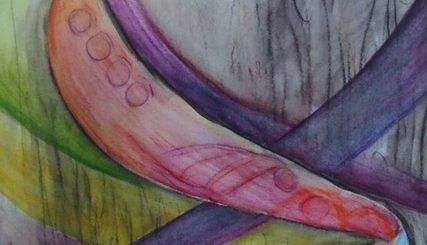Article submitted at request of trees in Trinity Bellwoods Park in Toronto. Not published by the newspaper.
Trees. Forgiving. Trees: FOR…GIVING.
Not long ago, I was at a party. Soon I was listening to a teacher from an elementary school, who told me that, when she was younger, and heading towards a nervous breakdown, as she described it, she had gone to Queen’s Park and lain face down on the roots of one of the venerable Oak trees. After a time she noticed in herself a new perspective, and the feeling she could carry on. She was sure the tree had helped her. “But,” she said furtively “I could never tell anyone but you that story.”
I laughed. “That’s what everyone says” I replied, “I bet before the evening is out other people will tell me similar things.” Sure enough, within half an hour I was listening to another teacher telling me that to cope with an abusive home life as a child she would bond with a tree every summer, sitting with it to eat, to read and to daydream. “But you would never tell anyone but me that.” I said with a smile.
That’s because, in some circles, I’m known as the lady who talks to trees. Actually I listen to trees. And people. They both have a lot to say.
The more we find out about trees, the more amazing they become. They’re a vital part of the planet, supporting ecosystems and communicating with each other and with other organisms.
Trees are, and always have been, useful to humans. An article on the Toronto Urban Forest in the Globe and Mail recently outlined the value of urban trees, in monetary terms, showing how they saved money on air conditioning, increased the value of property (by up to 27%) and so on.
Every equation has two sides though, and it would be useful to look at these benefits as an exchange for what we can give to the trees, and what they need from us? How, perhaps, we can collaborate with them to create new possibilities for health, community building, conflict transformation, the TREEforestation of the built environment? As it happens, trees prefer the term “Treeforestation” over “Reforestation”.
Personally, I have listened to over 400 trees in 10 countries. Many are ancient, up to 5,000 years old. When I am sitting with my back against a tree trunk I have with me a pad of watercolour paper and a set of coloured pencils. I direct my attention inwardly. I make a connection with the inner activity of the tree, and see what it shows me and I draw it.
To many, this seems very strange. But it’s not so different from the experiences of those teachers. Or from the experiences of hundreds of people I’ve spoken with over the years. People talk to trees, sing to them, and, of course, hug them. It’s not something everyone would admit to, but it happens. And it’s as natural as talking to cats.
If you walked past while I was in “conversation”, you would see a middle-aged woman sitting with her back against a tree, drawing with coloured pencils. I will sit for up to two hours drawing, and I never know what the drawing will look like until it’s done.
Most recently, I’ve turned my attention to trees in my own, beloved city of Toronto. And the trees here are showing me disturbing images. They are dying from the inside, the heartwood failing within.
This weakens the trees however when examined they would give the impression they are healthy. I have seen this with two mature red maple trees that were cut down for development on my street in Richmond Hill in the last weeks. As a trained forester would point out there are stresses on trees such as lack of water, extreme weather and construction to name a few. But as a former silvaculturalist (now farmer) said to me last week, he has noticed trees dying in a fashion that suggests damage to roots that he can’t explain by the usual stresses. He is baffled by what he is seeing both in the urban and rural settings.
I went to sit with the Siberian Elm tree in Trinity Bellwoods Park that recently dropped a branch which killed a man. It was my second visit to that tree after this tragedy. I was returning to fulfill a promise I had made to offer the trees in that park some nourishment and care. While sitting under the tree and listening, I prepared a biodynamic spray that supports the soil. I noticed many people on cell phones and other devices sitting up against trees. Others were walking about playing Pokémon Go using their devices. The tree showed me that, for them, this is like blasting loud harsh music. It causes discomfort and ultimately it is changing the trees’ ability to grow. You could say it is the last straw. Signals are everywhere. To us they are invisible and inaudible. For the trees these are disruptive and damaging. Can we listen to the trees?
Before I left the trees were asking me to advocate for cellphone-free parks.
Yes you read that correctly. The trees are asking for cellphone-free parks.


